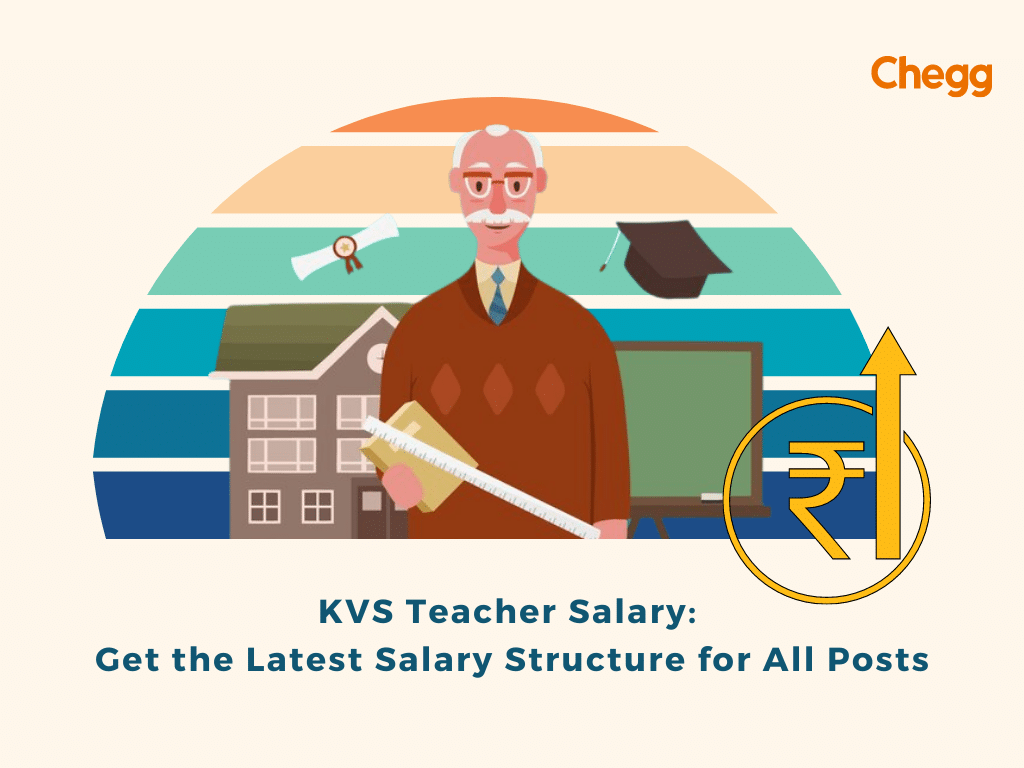Home » Govt Exams Blogs » KVS Teacher Salary 2024: Salary Structure, Pay Scale, Allowances & Benefits
KVS Teacher Salary 2024: Salary Structure, Pay Scale, Allowances & Benefits

Table of Contents
Table of Contents
KVS Teacher Salary 2024 offers competitive salaries for its teachers based on experience, education level, location, and subject taught. As of 2024, the KVS PRT salary ranges from Rs. 35,400 to Rs. 1,12,400 per month, the KVS PGT salary ranges from Rs. 47,600 to Rs. 1,51,100 per month, and the KVS TGT salary ranges from Rs. 44,900 to Rs. 1,42,400 per month. Contractual teacher salaries vary by post and location. Keep an eye out for updates to the salary structure and consider if it’s a good fit for your career goals.
This blog will provide the latest KVS teacher salary structure for all posts. This includes the KVS PRT, KVS TGT, KVS PGT, and KVS contractual teacher salaries. Keep reading to learn more about the salary structure of KVS teachers!
For the latest updates on this exam, read KVS Recruitment 2024: Latest Notification for PGT, TGT, PRT Post

KVS Teacher Salary 2024: Overview
Here is an overview of the latest KVS teacher salary structure for 2024, including the salary details for various teaching positions:
| Position | Salary Range |
| KVS Primary Teacher (PRT) | INR 35,400 to INR 1,12,400/month |
| KVS Trained Graduate Teacher (TGT) | INR 44,900 to INR 1,42,400/month |
| KVS Post Graduate Teacher (PGT) | INR 47,600 to INR 1,51,100/month |
| KVS Contractual Teacher | INR 21,250 to INR 27,500/month |
Please note that the above-mentioned salary ranges are subject to change depending on the location and the years of experience you have. KVS teachers also receive additional benefits such as medical insurance and pension plans.

KVS Teacher Salary Structure
KVS teachers’ salaries vary based on their education and experience. For example, PRTs can earn Rs. 35,400 to Rs. 1,12,400 per month, while PGTs can earn Rs. 47,600 to Rs. 1,51,100 per month.
TGTs and Contractual teachers have different salary ranges. Additional benefits include medical insurance and pensions. Salaries may be adjusted based on inflation and regional cost of living.
Here is a breakdown of the KVS teacher salary structure for 2024:
| Position | Basic Pay Range |
| PRT | Rs. 35,400 – Rs. 1,12,400 |
| TGT | Rs. 44,900 – Rs. 1,42,400 |
| PGT | Rs. 47,600 – Rs. 1,51,100 |
| Contractual Teacher | As per KVS norms |
KVS Teachers Salary for PGT Post
A PGT is a teacher who has completed post-graduation in a particular subject and is responsible for teaching senior secondary classes.
The KVS PGT salary structure varies depending on the years of experience and qualifications. Below is a table showing the detailed salary structure for KVS PGT:
| Pay Level | Entry Pay (Grade Pay 4,800) | Maximum Pay |
| Level 9 | Rs. 47,600 | Rs. 1,51,100 |
| Level 10 | Rs. 56,100 | Rs. 1,77,500 |
| Level 11 | Rs. 67,700 | Rs. 2,08,700 |
Apart from the basic pay, KVS PGTs are also eligible for various allowances, such as DA (Dearness Allowance), HRA (House Rent Allowance), and TA (Transport Allowance), among others.
KVS Teachers Salary for TGT Post
TGT stands for Trained Graduate Teacher, meaning they have completed their graduation and have a teaching degree. They teach middle or junior high school students, typically from classes 6 to 10.
The KVS TGT salary structure is based on the 7th Pay Commission, meaning teachers get a fixed monthly salary. In addition to the basic pay, they also get several allowances and benefits, such as medical insurance and pension plans.
Here’s a table that shows the detailed salary structure for KVS TGT teachers:
| Post | Basic Pay | Dearness Allowance | House Rent Allowance | Transport Allowance | Gross Salary |
| TGT | Rs. 44,900 | Rs. 5,388 | Rs. 4,480 | Rs. 3,600 | Rs. 58,368 |
KVS Teachers Salary for PRT Post
Now, let’s talk about the salary structure for KVS PRTs in 2024. The salary is based on experience and education level and varies by location. Below is a table showing the detailed salary structure for KVS PRTs in 2024:
| Post | Pay Scale | Basic Pay | HRA | DA | Gross Salary |
| PRT | Rs. 44,900-1,42,400 | 44,900 | 4,491 | 8,082 | Rs. 57,473 |
The above salary structure does not include additional benefits such as medical insurance and pension plans, which KVS teachers also receive.
Also read: KVS Syllabus, Exam pattern 2024: PRT, TGT, PGT Free download
KVS Teacher Salary: Allowances & Reimbursements
KVS offers a good salary to teachers based on their education and experience. The salary may vary depending on the location and subject taught.
For instance, KVS PRT (Primary Teacher) salary starts at around Rs. 35,000 per month, while KVS TGT (Trained Graduate Teacher) salary can be around Rs. 45,000 per month. On the other hand, KVS PGT (Post Graduate Teacher) salary may start from Rs. 47,000 per month. Therefore, contractual teachers’ salaries may be different from regular teachers.
Apart from the salary, KVS also provides various allowances and perks to its teachers. These include House Rent Allowance (HRA), Dearness Allowance (DA), and medical insurance. In addition, teachers may also get reimbursements for things like travel and education expenses. These extra benefits can make KVS a great place to work!
KVS Teacher Perks and Benefits
Besides the KVS teacher salary, teachers get other benefits such as health insurance, pension plans, and leave encashment. In addition, a provident fund is another benefit where a part of the salary is saved for retirement. These benefits make KVS a desirable workplace for aspiring teachers.
KVS Teacher Career Growth and Increments
Here is some information about career growth, promotions, and increments:
- Career Progression: KVS teachers have various opportunities for career growth, such as becoming a Headmaster, Principal, or even a Regional Director.
- Promotions: KVS follows a promotion policy based on seniority and performance, and promotions are granted after several years of service.
- Increments: Teachers can get increments based on their performance, qualifications, and experience.
- KVS Contractual Teacher Salary: The salary of contractual teachers is based on their qualifications and experience and is lower than that of regular KVS teachers.
KVS Teacher Salary FAQs
Yes, KVS teachers receive a pension plan as an additional benefit and medical insurance.
The salary of a CTET teacher varies based on experience, education level, location, and subject taught.
The highest post in KVS is the Principal post.
The in-hand salary of a KVS TGT teacher varies based on the location and experience, ranging from Rs. 35,000 to Rs. 45,000 per month.
It depends on the individual’s qualifications and experience, but KVS has a competitive hiring process.
CTET (Central Teacher Eligibility Test) is compulsory for KVS teachers.
The age limit for KVS teachers is 18-35 years, but there are age relaxations for certain categories.
Yes, KVS recruits teachers regularly, depending on their requirements.
The passing marks for KVS vary based on the post and category, but it is usually 50% or above.
The official website of KVS is kvsangathan.nic.in or Click here for the Direct link to the official website